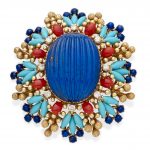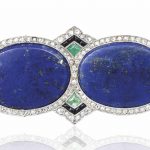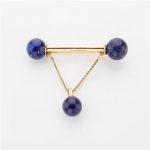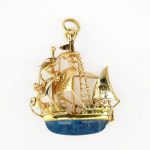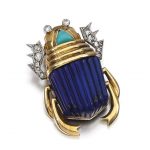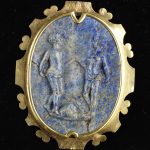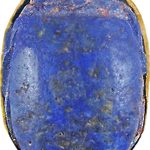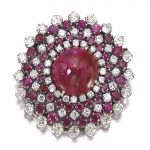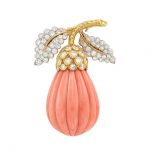Information and history of lapis lazuli plus a gallery of lapis lazuli used in antique and vintage brooches and other jewellery or artifacts. Lapis Lazuli has been mined since neolithic times. It was popular in many ancient cultures, such as the Akkadians, Assyrians, Babylonians and Ancient Egyptians. The Ancient Egyptians would often make scarabs, necklaces and many other items from this gemstone. Mixed with turquoise, coral and gold, it makes stunning pieces reminiscent of these ancient civilizations.
A lapis lazuli, turquoise, coral, diamond and gold brooch/pendant gross weight approximately: 46 grams; length: 2 3/8in.
Sold for US$ 2,125 (£ 1,596) inc. premium at Bonhams in 2018
ART DÉCO LAPIS LAZULI, DIAMOND, ONYX AND EMERALD BROOCH Lapis lazuli plaques, rose-cut diamonds, buff-top onyx and buff-top emeralds, 1920s, 6.8 cm
Sold for CHF 6,875 at Christies in 2018
Antique Gold and Lapis Fibula Brooch The gold cylinder tipped by 2 lapis beads, supporting a chain centering one lapis bead, 3 lapis beads ap. 17.0 to 15.8 mm., ap. 21.8 dwt.
Sold for $1,000 (includes buyer’s premium) at Doyle New York in 2009
A Portuguese Gold Brooch / Pendant. 19 karat yellow gold ship form brooch / pendant depicted atop a cabochon Swiss Lapis / Jasper 2″ x 1.5″ Wt: 16.7 grams
Sold For $325 at Susanin’s Auctions in 2018
Lapis lazuli, turquoise and diamond brooch, Cartier, 1940s Modelled as a scarab, the body set with a carved lapis lazuli, to a cabochon turquoise head and circular-cut diamond eyes, to rose diamond front legs, signed Cartier, numbered, French assay marks.
Sold for 6,875 GBP at Sothebys in 2018
Adam and Eve, cameo in lapis lazuli, Italy, ca. 1580-1600
The art of engraving gemstones has been admired since the early days of the Roman empire. It was revived in Europe during the Renaissance, and again in the 18th and 19th centuries. Cameos and intaglios were prized and collected, sometimes as symbols of power and mounted in jewelled settings, sometimes as small objects for private devotion or enjoyment. Carving in lapis lazuli was fashionable around 1600 in Italy and Bohemia, especially at the imperial court of Rudolf II in Prague.
Reference: © Victoria and Albert Museum
Sheet gold neatly molded across the back and around the edges of a lapis lazuli scarab, forms the surface into which finely detailed hieroglyphs are chased. A ring of sheet gold was added around the perforations at either end. The inscription reads “Chiefs of The Priestly Guild of Horus” which suggests that the ring was a mark of professional status.
1186-1070 BC (Late New Kingdom)
